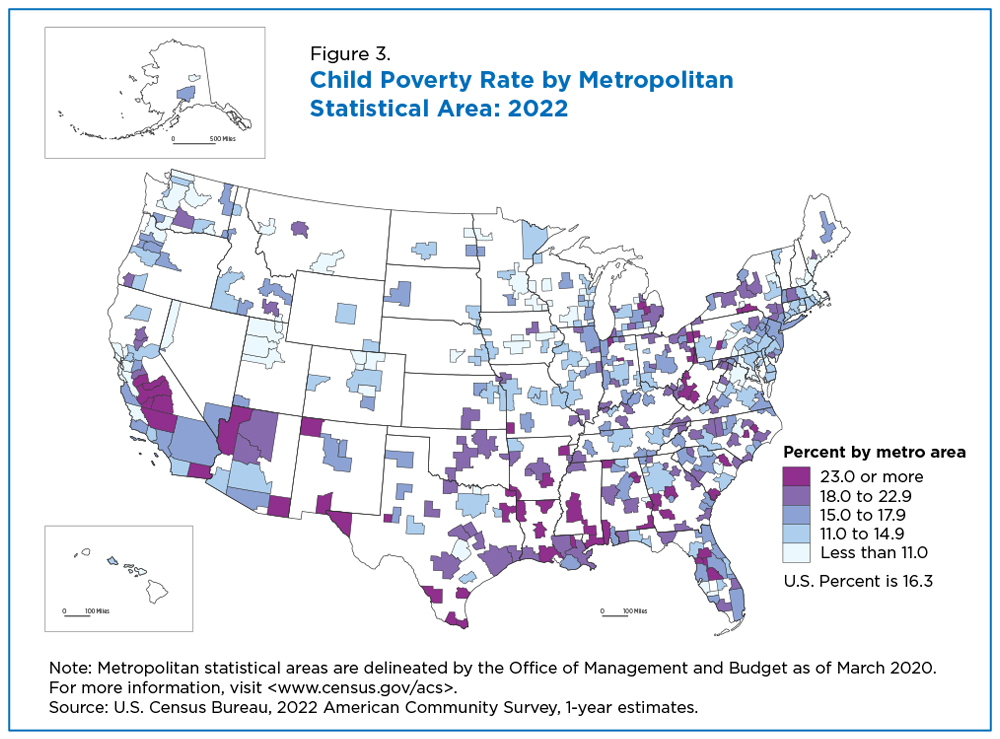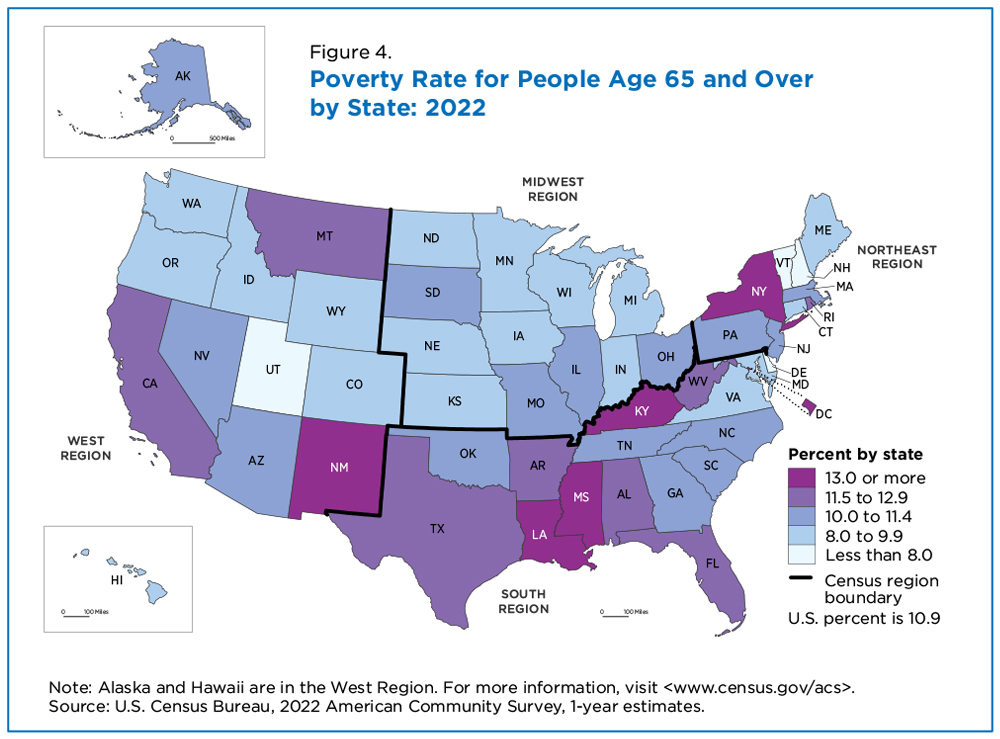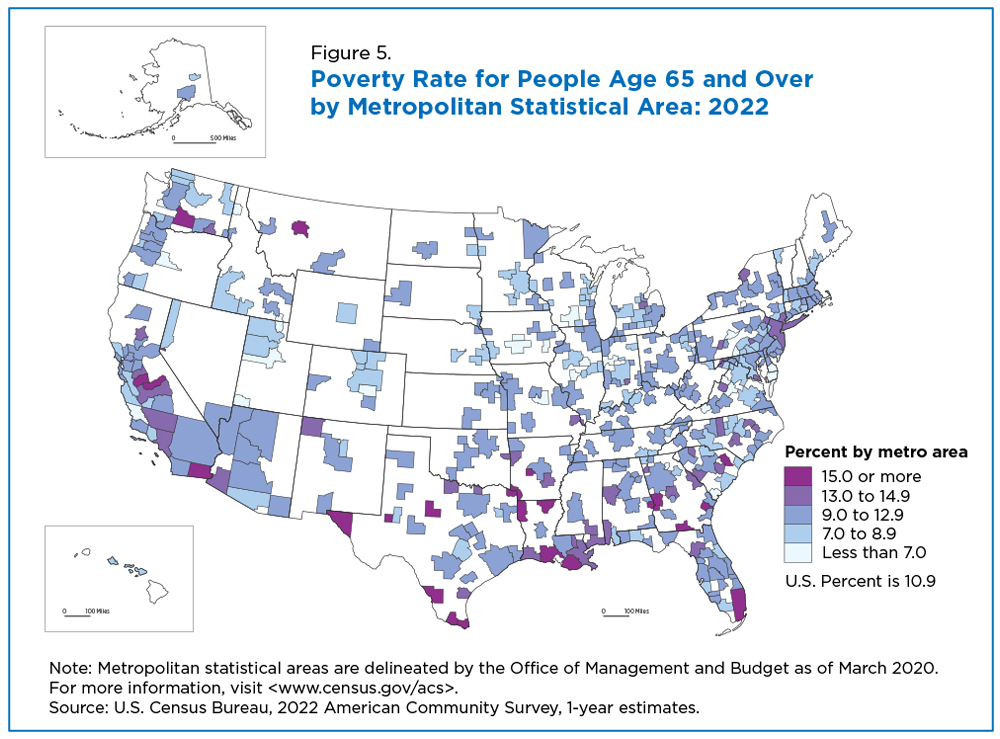Child Poverty Rate Still Higher Than For Older Populations But Declining
The U.S. official poverty rate as measured by the American Community Survey (ACS), was 12.6% in 2022 but the rate was significantly different for the nation’s oldest and youngest populations, according to a Census Bureau report released today.
The ACS shows that in 2022 the child (people under age 18) poverty rate was 16.3%, 3.7 percentage points higher than the overall rate. But the poverty rate among those age 65 and over was 10.9%, 1.6 percentage points lower than the overall rate. The poverty rate for those ages 18 to 64 was 11.7%.
In 2022, more than half (9) of the 17 states in the South region had child poverty rates of 18.0% or more, down from 12 Southern states and the District of Columbia in 2021.
The following maps show the difference in state poverty rates for these three age groups. For comparison, they use the same poverty rate category values.
Although lower than the child poverty rate, the poverty rate of those 65 and older rose 0.7 percentage points while the child poverty rate decreased by 0.7 percentage points from 2021 to 2022 — the first time since 2018 the rates changed in opposite directions. Twice before (2009 and 2010), the reverse happened; that is, child poverty went up and poverty among those age 65 and over went down.
The poverty picture in four states – Arizona, Georgia, Maryland and New Jersey – was the same as the national one in 2022: the rate increased among those age 65-plus and decreased for children.
How Poverty Is Measured
Poverty status is determined by comparing annual income to a set of dollar values (poverty thresholds) that vary by family size, number of children and the age of the householder.
If a family’s before-tax money income is less than the dollar value of their threshold, that family and every individual in it are in poverty. For people not living in families, poverty status is determined by comparing the individual’s income to their poverty threshold.
The poverty measure excludes children under age 15 who are not related to the householder, or people living in institutional group quarters or in college dormitories or military barracks.
Child Poverty by State, Region and Metro Area
The national child poverty rate was 16.3% but there was considerable variation among states, ranging from 6.9% to 26.4%.
Figure 2 illustrates the uneven distribution of child poverty among states. This map, though similar to the Under 18 map in Figure 1, here just focuses on child poverty and how states compared to each other in 2022 at this age level.
In 2022, more than half (9) of the 17 states in the South region had child poverty rates of 18.0% or more, down from 12 Southern states and the District of Columbia in 2021.
The Midwest, Northeast and West each had only one state with child poverty rates of 18.0% or more.
More than three-quarters of states in the Northeast and nearly 70% in the West had poverty rates below 15.0%, corresponding to the two lowest map categories for child poverty.
Child poverty rates by state:
- Among the lowest were in New Hampshire (6.9%) and Utah (8.4%). (These estimates are not significantly different from one another.)
- Among the highest were in Mississippi (26.4%), West Virginia (25.0%) and Louisiana (24.6%). (These estimates are not significantly different from one another.)
Eleven states and the District of Columbia had lower child poverty rates in 2022 than in 2021. Only one state, West Virginia, had a higher child poverty rate than in 2021.
Child poverty rates also showed wide variations among the nation’s 384 Metropolitan Statistical Areas or metro areas in 2022, ranging from 3.7% to 40.9% (Figure 3); 25 metro areas saw child poverty rates rise and 35 rates fall from 2021 to 2022.
Nearly two -thirds of the metro areas with the nation’s highest child poverty rates were in the South and accounted for about a quarter of all the South’s metro areas.
High-poverty metro areas were disproportionately represented in the South. In contrast, nearly 40% of metro areas with the lowest poverty rates were in the West.
Poverty Rate: Population 65 and Over
In 2022, the national poverty rate of people age 65 and over was 10.9%, significantly lower than the national and the child poverty rates but up from 10.3% in 2021, marking the second year in a row that this group’s poverty rates increased.
There were geographic variations from 7.5% to 15.9% in these poverty rates but they were not as pronounced as for the child poverty rate (Figure 4).
Eight states in the South and the District of Columbia had poverty rates of 11.5% or more. No other region had more than three states with such high poverty rates among the 65-plus population.
State poverty rates for oldest age group:
- Among the lowest: Utah (7.5%) Delaware (7.7%), Vermont (7.9%), New Hampshire (7.9%), and Colorado (8.0%). (These estimates are not significantly different from one another.)
- Among the highest were the District of Columbia (15.9%), Louisiana (14.8%) and Mississippi (14.7%). (These estimates are not significantly different from one another.)
In metro areas, older population poverty rates ranged from 3.4% to 25.7% (Figure 5).
In 2022, most of the nation’s 63 metro areas with older population poverty rates of 13.0% or higher were in the South (42) or the West (14). More than a quarter of all the South’s metro areas fell into the two highest poverty categories compared to just 3.2% of those in the Midwest.
Poverty rates among those age 65-plus rose in 44 metro areas and fell in 11 metros from 2021 to 2022.
Additional poverty data from the 2022 release and links to poverty estimates from other surveys (such as the Current Population Survey Annual Social and Economic Supplement and the Survey of Income and Program Participation) are available on this topics page.
Subscribe
Our email newsletter is sent out on the day we publish a story. Get an alert directly in your inbox to read, share and blog about our newest stories.
Contact our Public Information Office for media inquiries or interviews.











